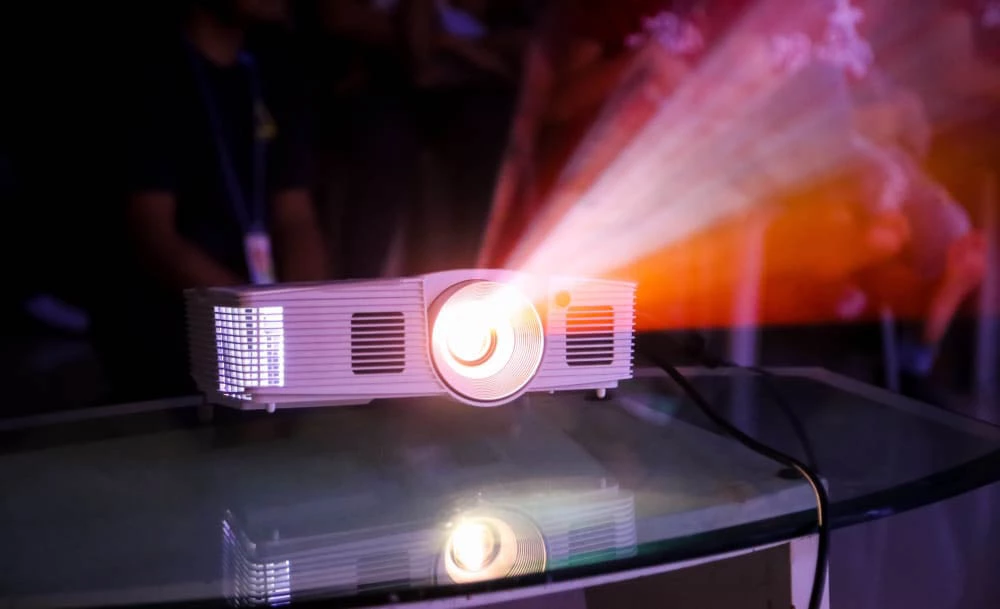Feeling overwhelmed by the number of 3D projectors available on the market? Look no further! This complete guide will help you find the best 3D projector for your needs.
You’ll discover why 3D projection is so important, and which features to look out for in order to make an informed decision. Get ready to experience the magic of 3D projection!
3D projectors add a whole new dimension to home theater, allowing viewers to truly immerse themselves in their favorite films and TV series. The newest 3D projectors use either active or passive 3D technology, which work with specialized glasses to achieve the illusion of depth.
Projectors that feature higher resolutions, better brightness and contrast, and faster refresh rates allow for an enhanced experience for gamers, as well as more realistic viewing for general movie-watching and TV shows. This guide will explain the types of 3D projectors available on the market today, their advantages and disadvantages, and provide tips on choosing the best projector for your home theater needs.
This guide is organized into five main sections: I. Introduction; II. Benefits of 3D Projectors; III. Types of 3D Projectors Available; IV. Buying Tips; V. Conclusion & Summary.
Explanation of 3D projectors
3D projectors provide a unique and immersive experience when watching movies or playing video games. Not only can they provide you with an unparalleled level of entertainment, but they can also have the added benefit of enhancing your work with any type of content.
These projectors work by opening up two channels within the same image, which creates an illusion of depth that realistically simulates 3D visuals. The viewer then has to wear glasses as each eye is then given its own set of imagery for a realistic 3D effect. This technology has played a major role in revolutionizing how home theaters and media rooms are enjoyed, and many movie fans now opt for these projectors for more immersive experiences.
The benefits of this technology are plentiful, from improved viewing angles to easier portability options than those available with traditional 3D TVs. As such, there is no doubt that this technology offers one of the most advanced experiences to households and businesses alike.
The technical aspects involved in operating and setting up these projectors can be overwhelming, however. To make it easier to understand all the ins-and-outs of these devices, here is an overview guide explaining what you need to know about buying and using one.

Small LCD video projector on table in living room, watching movies in home theater
Benefits of owning a 3D projector
A 3D projector can bring a whole new dimension to entertainment at home, allowing you to experience your favourite movies and games in vivid, lifelike detail. Not only that, but they are also compact and easy to install into most modern homes. With powerful visuals delivered straight from the comfort of your home, 3D projectors provide a level of immersion and convenience that other alternatives just can’t match. Here are some of the benefits that come with owning a 3D projector:
-Full Immersion: Viewers can immerse themselves in their favourite movies as if they were actually in the action—you don’t get this kind of immersive experience from traditional 2D screens.
-Cost-Effective: Home cinema setups featuring 3D projectors often cost less than similar setups featuring TVs or monitors.
-Compact Size: Most modern 3D projectors are small enough to fit into your living room without taking up a lot of space—they’ll blend right in with the rest of your décor.
-Realistic Visuals: By displaying images on a larger surface such as a wall or screen, viewers get more realistic visuals compared to simply watching it on their computer or TV screen.
-Low Maintenance Requirements: The majority of models require just basic setup and minimal maintenance once they have been installed in the home cinema system. Plus, they typically require no special tools for installation or operation!
Importance of choosing the right 3D projector
The right 3D projector for your needs can greatly enhance your movie-viewing experience. Not all 3D projectors are created equal; each one comes with different features and settings that need to be taken into consideration before making a purchase. Some projectors offer advanced calibration and customization options that let you get the most out of your viewing experience, while others provide brightness or contrast levels that won’t do justice to the movies you love.
When looking for a 3D projector, it is important to consider several factors: viewing distance, resolution and brightness. The viewing distance should allow for a larger display area so that there is more clarity in the image; higher resolution ensures more vibrant colors and sharper pictures; and adequate brightness allows you to make out all of the details in darker scenes without losing visibility. Additionally, make sure the projector supports different input sources like HDMI, USB ports or VGA connections so you can view content from many types of media devices with ease.
Most importantly, research brands and reviews before making your purchase so you end up with the best projector for your needs. Consider asking around at local stores or talking to fellow movie fans on social media platforms like Reddit to get feedback on what model may fit best for what you’re looking for in an entertainment solution. Following these steps will help ensure you have an enjoyable experience every time!
Factors to Consider when Choosing a 3D Projector
When selecting a 3D projector, there are several factors you should consider. These include: brightness, resolution, price and compatibility with your 3D glasses or goggles.
Brightness: For bright, vivid images and for the best 3D performance, you will typically want to choose a projector that has 2500 lumens of brightness or higher. This will ensure the highest level of image quality regardless of the room’s lighting conditions.
Resolution: The available resolutions for 3D projectors range from standard XGA (1024×768) to ultra-high 1080p (1920×1080). Generally speaking, the higher the resolution the better your image quality. The standard XGA resolution is suitable for smaller theaters or home theater set-ups, while 1080p is ideal for larger theaters and cinemas.
Price: As with any type of technology product, there is an array of options available at various price points to suit nearly any budget. Depending on your individual needs and budget constraints you may just want an entry-level model or perhaps a higher end option that better suits your requirements.
Compatibility: It’s important to make sure that any 3D projector you buy is compatible with both active shutter and passive glasses in case you have multiple types of viewers in one room or area. This can provide smoother transitions between watching movies using active shutter glasses in one area and then passive glasses in another area without having to change out all the accompanying hardware items such as splitters and emitter boxes etc…

Brightness
When considering the brightness of a 3D projector, look into lumens, or the measurement of light emitted. The definition of a lumen is “in relation to a given source, luminous flux per unit solid angle per unit projected source area.” This simply means that a greater number of lumens indicates a brighter image.
Most 3D projectors available for purchase have between 2,000 and 6,000 lumens and those with 4,000 or more are generally considered bright enough for most environments. If the projector will be used in direct sunlight or a well-lit area, you may want to purchase one with 6,000 lumens or more to ensure optimal performance.
Additionally, if you anticipate using your projector in different environments from meeting rooms to lecture halls or rental spaces throughout your facility best practice is to get one with at least 5,000 lumens so you could adjust it accordingly no matter what kind of space you use it in.
Contrast ratio
The contrast ratio is an important factor in determining how vibrant the picture quality will be in regards to blacks and whites. The higher the contrast ratio, the greater the range of brightness, making for a more lifelike image.
Generally speaking, lower-end projectors offer 2000:1 contrast ratios while mid-range models boast 3000:1 and high-end models provide 4000:1 or greater. It’s important to note that larger figures do not automatically mean a better picture – after all 1080p is still considered the HD gold standard by many.
Resolution
When considering 3D projectors, the resolution should be one of your first considerations. For an excellent 3D experience, you’ll want a projector that will produce a high resolution image with sharp edges and distinctive images.
3D projectors come in two resolutions- 1080p and 4K.
1080p resolution produces a picture with 1920 pixels horizontally by 1080 pixels vertically and is the same resolution as High Definition (HD). This is the minimum resolution required for good quality 3D projection.
4K resolution projects 4096 pixels horizontally by 2160 vertically, twice the vertical and twice the horizontal pixel count of 1080p. With four times as many total pixels onscreen at once, you get much more detail in your image – much sharper edges, better clarity, more accurate color rendering for lifelike pictures. This can make objects on screen seem much bigger with more depth than lower resolutions like 720p or 1080p.
Throw ratio
Throw ratio is the ratio of the projector’s distance from the screen and width of the projected image. A projector with a lower throw ratio is most suitable for small to medium sized rooms. Opting for a short-throw projector in these circumstances will cost you more but will give you a better viewing experience due to its ability to produce bigger images in smaller areas.
Long-throw projectors are best suited for larger spaces and allow users to sit further away and still enjoy the 3D projections without compromising on image quality.
When shopping for 3D projectors, keep in mind that high-quality resolutions need a larger room than lower resolutions, because they generate brighter images which require greater space to appreciate them in projection form.
Connectivity
When selecting a 3D projector, it is important to consider the types of connectors available. The most common kind is HDMI, as this is an industry-standard connection. It allows for high-definition video and audio to be piped from the source device to the projector. It also has support for dynamic 3D content.
Other connectivity options available on some models include VGA ports for compatibility with computers and laptops, Composite connections which accept older video sources, or wireless streaming solutions. This allows you to project content without having physical connections limiting your screen size or placement options.
Make sure your projector has all the necessary ports compatible with your current devices to ensure a seamless experience when setting up your home theater system.

Conclusion
When looking for the best 3D projectors, there are a few things to consider. Do your research, understand the technology and features available, read customer reviews, and determine what features are important for you. This will help you make an informed decision and get a projector that suits your needs perfectly.
Ultimately, it’s all about finding a projector that can provide quality results while fitting your budget. With the right 3D projector in hand, you’ll be able to experience the magical world of 3D right at home any time of day or night!
FAQs
Which projector is best for 3D?
The best projector for 3D is one that offers high brightness, contrast, and resolution, such as the Optoma HD29Darbee, BenQ HT2550, and Epson Home Cinema 5050UB.
How good is 3D on a projector?
3D on a projector can be very good, as projectors offer larger screen sizes than televisions, providing a more immersive viewing experience. However, the quality of the 3D experience depends on the quality of the projector and the content being played.
What are the uses of 3D projector?
3D projectors can be used for a variety of applications, such as home theater, gaming, education, and professional use, such as in architecture or engineering.
Are 3D projectors still made?
Yes, 3D projectors are still being made, although they are becoming less common as 3D content becomes less popular.
Which is the best projector in market?
The best projector in the market depends on the specific needs of the user, as different projectors offer different features and specifications. Some top models include the Epson Home Cinema 5050UB, Sony VPL-VW295ES, and BenQ HT3550.
What is the meaning of 3D projector?
A 3D projector is a type of projector that is capable of displaying images in three dimensions, providing a more immersive viewing experience.
Can I watch any movie in 3D on projector?
No, not all movies are available in 3D, and not all projectors are capable of displaying 3D content. However, many modern projectors have 3D capabilities and can display 3D movies when connected to a 3D-enabled device.
What is a 3D ready projector?
A 3D-ready projector is a projector that is capable of displaying 3D content when connected to a 3D-enabled device, such as a 3D Blu-ray player or a gaming console.
Why 3D is good?
3D provides a more immersive viewing experience, allowing viewers to feel like they are part of the action. It can also enhance depth perception and provide a more realistic representation of objects and environments.
Who invented 3D projector?
The first 3D projector was invented by Edwin H. Land, the founder of Polaroid Corporation, in the 1950s.
See Also:
- Best projectors for business
- Best projectors for presentations
- Best projectors for churches
- Best 3d projectors
- Best projectors for sports

